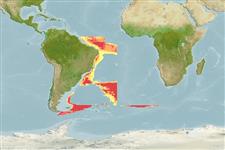Environment: milieu / climate zone / depth range / distribution range
Écologie
marin bathypélagique; profondeur 229 - ? m (Ref. 26282). Deep-water
Southwest Atlantic: off Amazon River mouth, northern Brazil.
Taille / Poids / Âge
Maturity: Lm ? range ? - ? cm
Max length : 7.5 cm SL mâle / non sexé; (Ref. 37108)
Épines dorsales (Total) : 5; Rayons mous dorsaux (Total) : 13; Épines anales: 2; Rayons mous anaux: 9. Body slender. Head slightly longer than deep. Snout blunt and rounded. Back and sides light reddish brown, lower sides dark gray to black (Ref. 37108).
Minimum depth from Ref. 58018.
Life cycle and mating behavior
Maturities | Reproduction | Spawnings | Egg(s) | Fecundities | Larves
Moore, J.A., 2003. Trachichthyidae.Slimeheads (roughies). p. 1184-1188. In K.E. Carpenter (ed.) FAO species identification guide for fishery purposes. The living marine resources of the Western Central Atlantic. Vol. 2: Bony fishes part 1 (Acipenseridae to Grammatidae). (Ref. 51171)
Statut dans la liste rouge de l'IUCN (Ref. 130435)
Menace pour l'homme
Harmless
Utilisations par l'homme
Pêcheries: sans intérêt
Outils
Articles particuliers
Télécharger en XML
Sources Internet
Estimates based on models
Preferred temperature (Ref.
123201): 0.5 - 3.4, mean 1.8 °C (based on 167 cells).
Phylogenetic diversity index (Ref.
82804): PD
50 = 0.5039 [Uniqueness, from 0.5 = low to 2.0 = high].
Bayesian length-weight: a=0.01047 (0.00413 - 0.02653), b=3.03 (2.81 - 3.25), in cm total length, based on LWR estimates for this (Sub)family-body shape (Ref.
93245).
Niveau trophique (Ref.
69278): 4.2 ±0.73 se; based on food items.
Résilience (Ref.
120179): Milieu, temps minimum de doublement de population : 1,4 à 4,4 années (Preliminary K or Fecundity.).
Fishing Vulnerability (Ref.
59153): Low vulnerability (10 of 100).
